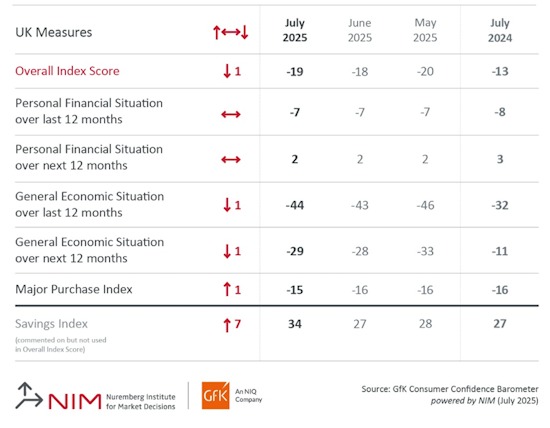Retail sales in the UK rebounded less than expected in June, despite the warm weather helping to drive a recovery in food stores.
The data from the Office for National Statistics (ONS) shows sales volumes increased by 0.9%, recovering from a 2.8% fall in May, although behind economists’ forecast of a 1.2% rise.
Quarterly sales volumes (Q2 vs. Q1) also rose slightly by 0.2%, and were up 1.7% year-over-year, although they were still 1.6% below pre-pandemic levels. Most retail sectors experienced growth, particularly supermarkets, automotive fuel, and online retailers, driven by promotions and favourable weather conditions. However, some non-food areas, such as household goods and second-hand retailers, experienced declines due to reduced foot traffic.
Online sales values increased by 2.3% over the month and by 4.5% annually, increasing the channel’s share of total retail sales from 27.4% in May to 27.8%.
“While headline sales figures for June suggest modest momentum on the surface, much of the uplift was seasonal and driven by heavy promotional activity around events, sport and warmer weather,” said Nicholas Found, Head of Commercial Content at Retail Economics.
“Beyond that, demand remains selective. Food inflation is hitting households harder, leading to tighter budgets and renewed uncertainty around the cost of living.
“Consumers continue to reframe their priorities, with discretionary spending leaning toward experiences and categories where value can be clearly demonstrated.
“Retailers are walking a fine line. They are working to attract demand without sacrificing margins, all while contending with new structural cost pressures following the Budget. It’s a summer of cautious opportunity, but any resurgence in non-essential retail spending is likely to remain patchy, unless there’s a more meaningful improvement in discretionary incomes and consumer confidence.”
Separate data released today by GfK confirmed that consumer confidence remained subdued amid concerns about the economy. The Index decreased by one point to -19 in July, with two measures down, one up, and two unchanged in comparison to last month’s announcement.

Neil Bellamy, Consumer Insights Director at GfK, commented: “The key measures on personal finances, the economy and purchase intentions are flat in July, and many will conclude that consumers are in a cautious wait-and-see mood. But the data suggests that some people may be sensing stormy conditions ahead. With speculation growing over possible tax rises in the Autumn Budget, and price pressure contributing not just to higher inflation already but also to the likelihood of worse inflation to come, the news is worrying.”
He noted that it’s unlikely that the Index will improve in the months to come. “It has drifted quietly downwards over the past year, and any fresh challenges or shocks could easily push confidence sharply lower,” Bellamy said.
NAM Implications:
- We are still in flatline demand territory…
- …with little by way of encouraging signs of improvement for market realists.
- Causing consumers to shop around by product (own-label) and format (discounters) for value…
- And it ain’t getting better.
- (Real growth has to come at the expense of rivals…)




